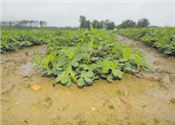|
Soybean, Peanut Acreage Exceeds Early Forecasts As Cotton Tumbles

Rainfall soaks into peanut rows on July 2, 2020, in Monroe County, Mississippi.
Photo by MSU Extension Service/Kevin Hudson
STARKVILLE, MISS.
Cotton and corn acreage in Mississippi are more than 30 percent below March projections, while growers of soybeans and peanuts planted much more than initially forecasted.
The U.S. Department of Agriculture National Agricultural Statistics Service released a report at the end of June updating the amount of crop acreage planted statewide. It compared those amounts to how much growers said they would plant when surveyed before planting season. Rice and hay acreage are unchanged from the USDA projection report published in March.
Cotton acreage is estimated at 520,000 acres, down 160,000 acres from March planting intentions. Corn acreage is also down, with 550,000 acres planted instead of the initially projected 710,000.
Many acres initially set aside for corn was planted in soybeans, with an estimated 2 million acres of that crop planted. That amount is 150,000 more acres than forecasts indicated four months ago and up 340,000 acres from last year.
“There were several factors that led to our soybean acreage increase,” said Trent Irby, soybean specialist with the Mississippi State University Extension Service. “Weather issues that knocked out a fair number of intended corn acres and falling commodity prices of other crops both contributed to more soybean acres in 2020.
“Also, the 2019 soybean report reflected the significant acreage that was left unplanted due to flooding in the Mississippi Delta, so many of those acres were put back into soybeans in 2020,” he said.
MSU Extension cotton specialist Brian Pieralisi and agricultural economist Will Maples pointed to market issues as the leading reason for growers backing off from planting as much cotton.
“I do not think this reduction can be blamed on environmental conditions because most of the state experienced above average planting conditions,” Pieralisi said. “Cotton production is expensive, and that, coupled with bearish market conditions, resulted in fewer planted acres. As prices fell below 60 cents, producers had a more difficult time penciling in a profit, especially if planting outside the optimum planting window in early May.”
From an economic perspective, Maples suggested the impact of COVID-19 on the overall economy as another factor for reduced cotton acreage. He attributed concerns of excess supply to the scaling back of corn planting.
“These effects had a severe negative impact on the cotton market,” he said. “The fundamentals are showing a high level of cotton stocks and decreased demand with the shutdown of economies worldwide. These factors have kept cotton prices down and probably convinced many producers to change their decisions to plant cotton this year.
“Nationally, the March corn acreage numbers were near a record high and signaled a potentially record corn supply,” Maples added. “The market reacted with low prices and convinced some producers to rethink planting corn. That is especially true for the Midwest.”
Extension corn and wheat specialist Erick Larson said decreased corn acreage was weather driven.
“Mississippi growers were unable to plant corn because relentless rainfall drastically restricted planting operations throughout prime planting time in March and April for most of the crop-growing regions in Mississippi,” he said. “There were only a few, sporadic days through the spring when well-drained fields dried enough to allow tractors a chance to get in fields to plant.
“Many growers abandoned a considerable portion of their corn planting intentions before a suitable planting window of opportunity finally occurred in the last few days of April and first week of May,” Larson said.
Mississippi winter wheat acreage remains at historically low levels at 40,000 acres, down 5,000 from March estimates.
“Record rainfall during the first quarter of 2020 limited wheat productivity and may have caused some acres to be abandoned prior to harvest this spring,” Larson said.
Peanut-planted acres are estimated at 25,000, which is up 5,000 acres both from 2019 and from March planting intentions.
“I would attribute a majority of the increased peanut acreage this year to markets,” said Brendan Zurweller, MSU Extension peanut specialist. “Most peanut producers are also cotton producers. The potential profit margin based on price received has been more favorable for peanuts when compared to cotton. This has resulted in many peanut and cotton growers pushing their rotations towards peanuts as much as they can.”
Rice planting is unchanged from March estimates at 150,000 acres. Expected hay harvest is about 620,000 acres. ∆
|
|